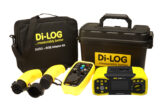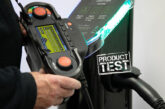
Pete Monfort, Director of Monty Electrics, Arena Training Centre and Sheffield Meadowhall AM2 Centre, takes a safety first approach as he tries out the Di-LOG 6790 CombiVolt 2 and PU690 Proving Unit.
There’s been lots of activity in the trade press and on social media in recent times, reminding electricians of the importance of safe isolation.
Indeed, I’d recommend that fellow professionals check out Michael’s Story and the video that was recently added to the IET’s YouTube channel, which identifies additional steps that should now become part of the method statement for safe isolation, a procedure that ALL electricians should follow every time they work.
A key piece of equipment for safe isolation is, of course, a suitable approved voltage indicator so I was excited to receive two Di-LOG 6790 voltage continuity testers to review, along with the PU690 proving unit.
As someone who runs a very busy electrical training centre I was able to put these into immediate use in our workshops, with everyone – from novice to seasoned veteran – getting hands-on with them.
The 6790 is supplied with 2 x AAA batteries and the unit is a lightweight but robust construction. The rubber finish will be excellent in warmer environments, providing a high level of grip and avoiding the possibility of hands slipping. In any event, there are finger guards and probe covers which ensure compliance with the all-important GS38 Electrical test equipment for use on low voltage electrical systems document that’s produced by the HSE.
Straightforward voltage testing
Cat IV rated, the tester is suitable for use on single and three phases and nominal voltages up to 600V. Additionally, the PU690 proving unit allows for confirmation that the tester is functioning correctly, whether for continuity (by pressing the probes together) or voltage (by use of the PU690 proving unit before/after, proving a supply is dead).
Voltage testing is very straightforward – simply place the probes on the AC or DC supply. Clear indication is provided and the probes are marked with ‘+’ and ‘–’ for DC measurements with an audible reverse polarity warning. The actual voltage is clearly shown with LEDs and on the LCD screen, while a single probe live test is also available to check for supply.
Moving on from safe isolation, the Di-LOG unit will also indicate continuity which is particularly useful for making quick checks on connections or when you’re fault finding. An added extra feature is the phase rotation test, and the key thing here is to make sure you orientate the probes correctly since the display provides a clear indication of rotation using LEDs to show right or left rotation.
That said, the instructions clearly state the product is for use by a competent person so it’s a straightforward test that only requires a couple of minutes to familiarise yourself with the kit.
One thing I really like about the unit is the simplicity of design, and I was impressed at how quickly new users were able to pick it up and get used to it. It’s a doddle to operate, gives clear indications and has already had lots of use across both of our electrical and training businesses.
A competitively priced product that is an essential tool for any business, the Di-LOG 6790 CombiVolt 2 and PU690 proving unit gets two thumbs up from me!
View the Di-LOG safe isolation series flyer by clicking here









